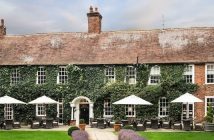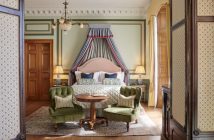Conjure up an image of an English countryside idyll. Are you seeing stone cottages, a sprawling garden, cosy bedrooms, cavernous fireplaces and a pub within a stone’s throw? You are unknowingly picturing the Cotswold destination Thyme, which has now flung open its doors to B&B visitors to make things easier for those of us who don’t have a coterie of friends with whom to rent the entire hotel out. It all started in 2002, when founder Caryn Hibbert and her family moved into the Manor House with a view to restoring it. Gradually, they bought – and set about renovating – the neighbouring farmhouses and barns. And so Thyme was born.
My appreciation for the estate should probably be prefaced with the admission that as a staunch city girl, it took a while for the countryside and me to get on. My first weekend in the country as a teen was an unmitigated disaster: when staying at a school friend’s house for the weekend, I ran a warm bath with the intention of hunkering down in it with a book for a good hour, as I believed one did when presented with a bath overlooking fields of grazing sheep. You’ll forgive my surprise, then, when I was rather unceremoniously told five minutes in to make way for the next bather, who’d be hopping into the water I’d left in the tub; warm water was scarce in this house thanks to some rather old plumbing. Next came dinner, the preparation of which I was invited to partake in. It was freshly-shot pheasant, bloodied and unplucked. I’m a vegetarian so went a little hungry that evening. I decamped to London the following day vowing never to return to the countryside lest I was sure it would be a little more comfortable.

Looking at the Thyme website, no knot of fear that I’d endure similar trials presented itself – it seductively promised countryside authenticity, but with the all-important luxury leanings. The overarching mission is particularly agreeable to those of us wanting to escape the pace of the city; Thyme wants to acquaint guests with the restorative rhythms of the countryside. This involves everything from helping to harvest the food growing on their land (and cooking it in their highly-regarded cookery school, but we’ll get to that later), to whiling away a few hours in The Swan, a 17th Century village pub a stone’s throw from the cluster of sensitively-restored medieval cottages and barns that comprise the sleeping quarters at Thyme.
Let’s start the tour with the rooms – they are so very important to we indoorsy folk and I was accordingly eager to settle into mine. There are 15 of them in total: 8 bedroom suites and a series of houses and cottages. Each has been treated as a single body that’s part of a whole – while the antiques may be different, the walls of varying pastel hues, and the baths dotted either next to the bed or in a bathroom, they’ve all been subject to the attention of Caryn and Roger Hall (the interior designer with whom she worked).

As Caryn showed me round, it became apparent that her meticulous eye had appraised – and improved – every element of the properties while remaining faithful to the quintessentially English aesthetic that Thyme has embraced: “that wall there wasn’t straight, but of course we couldn’t change that, so Roger and I came upon the idea of painting a border onto the wall to give the illusion of symmetry,” she tells me. “Oh, we had to gut everything, but all the rooms couldn’t match in the higgledy-piggledy building so we did each one up separately to avoid bleaching out quirks.” So there you have it – at Thyme, even the exquisitely-painted walls retain that hallmark of Britishness: eccentricity.
That night, we started the evening with a botanical cocktail in the Baa. The bar/Baa, is open to guests throughout the day and serves up little snacks and cocktails all inspired by the seasonal produce. Warmed after the tipple, we headed to The Swan at Southrop, guided across the cobbled street just outside the estate’s walls by lanterns and our noses – the wafts of herbs in the air proved a sure indication that this was indeed a pub of uncommonly good fare. Worry that this would prove a repeat of my first countryside experience set in when my party started to become excitable over the meat portion of the menu (roast partridge, pork cutlets and chargrilled sirloin all featured), though this was quickly dispelled: hand-harvested vegetables from the Thyme estate were well represented on the menu, and I tucked into a delicious vegetable broth, Cep mushroom risotto served with cavolo nero and buttered kale, and then polished off a quince and Southrop honey cake.

The following day continued the food glorious food theme. It started with a breakfast of freshly-laid eggs, warm, crumbly croissants and a rather greedy few spoons of homemade granola in the Tithe Barn. After a walk around the estate gardens to see the vegetables, we joined chef Daryll Taylor in the purpose-built cookery school to try our hand at cooking Thai street food. As I rolled my Hanoi spring rolls into neat parcels, I lost myself entirely in the task. It felt remedial somehow, the act of going back to school simply for the pleasure of it. At that moment, it was very clear that this love of food – from the growing and harvesting to cooking – is the thing that is at the beating heart of the enterprise.
Before leaving, I took a final wander around the estate to drink in the last of Thyme before hopping on the train back to London. I walked past the achingly beautiful Norman St. Peter’s Church in which Kate Moss held her nuptials in 2011 and into the farmyard. On seeing some rather tired looking chickens, I asked the gardener whether they were still laying eggs. “Oh no! They’re too old – they’re just here for their retirement!”. Any room in the coop for a frazzled Londoner?
For more information about Thyme, including details of the cookery school, things to do and moments of inspiration, visit www.thyme.co.uk.




